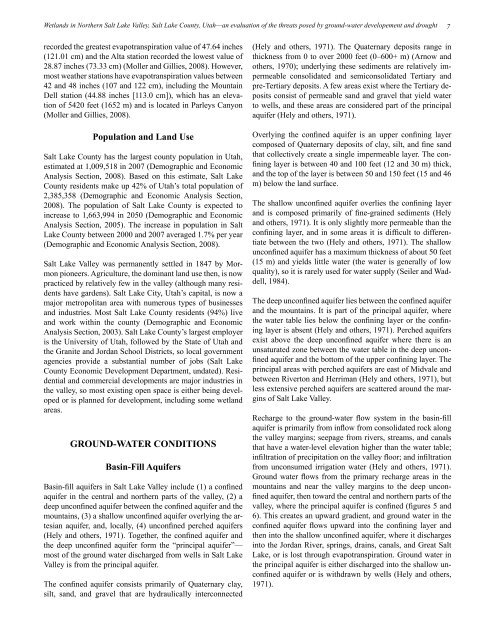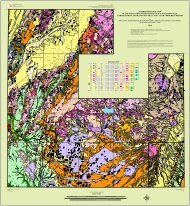Wetlands in northern Salt Lake Valley, Salt Lake County, Utah
Wetlands in northern Salt Lake Valley, Salt Lake County, Utah
Wetlands in northern Salt Lake Valley, Salt Lake County, Utah
You also want an ePaper? Increase the reach of your titles
YUMPU automatically turns print PDFs into web optimized ePapers that Google loves.
<strong>Wetlands</strong> <strong>in</strong> Northern <strong>Salt</strong> <strong>Lake</strong> <strong>Valley</strong>, <strong>Salt</strong> <strong>Lake</strong> <strong>County</strong>, <strong>Utah</strong>—an evaluation of the threats posed by ground-water developement and drought 7recorded the greatest evapotranspiration value of 47.64 <strong>in</strong>ches(121.01 cm) and the Alta station recorded the lowest value of28.87 <strong>in</strong>ches (73.33 cm) (Moller and Gillies, 2008). However,most weather stations have evapotranspiration values between42 and 48 <strong>in</strong>ches (107 and 122 cm), <strong>in</strong>clud<strong>in</strong>g the Mounta<strong>in</strong>Dell station (44.88 <strong>in</strong>ches [113.0 cm]), which has an elevationof 5420 feet (1652 m) and is located <strong>in</strong> Parleys Canyon(Moller and Gillies, 2008).Population and Land Use<strong>Salt</strong> <strong>Lake</strong> <strong>County</strong> has the largest county population <strong>in</strong> <strong>Utah</strong>,estimated at 1,009,518 <strong>in</strong> 2007 (Demographic and EconomicAnalysis Section, 2008). Based on this estimate, <strong>Salt</strong> <strong>Lake</strong><strong>County</strong> residents make up 42% of <strong>Utah</strong>’s total population of2,385,358 (Demographic and Economic Analysis Section,2008). The population of <strong>Salt</strong> <strong>Lake</strong> <strong>County</strong> is expected to<strong>in</strong>crease to 1,663,994 <strong>in</strong> 2050 (Demographic and EconomicAnalysis Section, 2005). The <strong>in</strong>crease <strong>in</strong> population <strong>in</strong> <strong>Salt</strong><strong>Lake</strong> <strong>County</strong> between 2000 and 2007 averaged 1.7% per year(Demographic and Economic Analysis Section, 2008).<strong>Salt</strong> <strong>Lake</strong> <strong>Valley</strong> was permanently settled <strong>in</strong> 1847 by Mormonpioneers. Agriculture, the dom<strong>in</strong>ant land use then, is nowpracticed by relatively few <strong>in</strong> the valley (although many residentshave gardens). <strong>Salt</strong> <strong>Lake</strong> City, <strong>Utah</strong>’s capital, is now amajor metropolitan area with numerous types of bus<strong>in</strong>essesand <strong>in</strong>dustries. Most <strong>Salt</strong> <strong>Lake</strong> <strong>County</strong> residents (94%) liveand work with<strong>in</strong> the county (Demographic and EconomicAnalysis Section, 2003). <strong>Salt</strong> <strong>Lake</strong> <strong>County</strong>’s largest employeris the University of <strong>Utah</strong>, followed by the State of <strong>Utah</strong> andthe Granite and Jordan School Districts, so local governmentagencies provide a substantial number of jobs (<strong>Salt</strong> <strong>Lake</strong><strong>County</strong> Economic Development Department, undated). Residentialand commercial developments are major <strong>in</strong>dustries <strong>in</strong>the valley, so most exist<strong>in</strong>g open space is either be<strong>in</strong>g developedor is planned for development, <strong>in</strong>clud<strong>in</strong>g some wetlandareas.GROUND‐WATER CONDITIONSBas<strong>in</strong>‐Fill AquifersBas<strong>in</strong>-fill aquifers <strong>in</strong> <strong>Salt</strong> <strong>Lake</strong> <strong>Valley</strong> <strong>in</strong>clude (1) a conf<strong>in</strong>edaquifer <strong>in</strong> the central and <strong>northern</strong> parts of the valley, (2) adeep unconf<strong>in</strong>ed aquifer between the conf<strong>in</strong>ed aquifer and themounta<strong>in</strong>s, (3) a shallow unconf<strong>in</strong>ed aquifer overly<strong>in</strong>g the artesianaquifer, and, locally, (4) unconf<strong>in</strong>ed perched aquifers(Hely and others, 1971). Together, the conf<strong>in</strong>ed aquifer andthe deep unconf<strong>in</strong>ed aquifer form the “pr<strong>in</strong>cipal aquifer”—most of the ground water discharged from wells <strong>in</strong> <strong>Salt</strong> <strong>Lake</strong><strong>Valley</strong> is from the pr<strong>in</strong>cipal aquifer.The conf<strong>in</strong>ed aquifer consists primarily of Quaternary clay,silt, sand, and gravel that are hydraulically <strong>in</strong>terconnected(Hely and others, 1971). The Quaternary deposits range <strong>in</strong>thickness from 0 to over 2000 feet (0–600+ m) (Arnow andothers, 1970); underly<strong>in</strong>g these sediments are relatively impermeableconsolidated and semiconsolidated Tertiary andpre-Tertiary deposits. A few areas exist where the Tertiary depositsconsist of permeable sand and gravel that yield waterto wells, and these areas are considered part of the pr<strong>in</strong>cipalaquifer (Hely and others, 1971).Overly<strong>in</strong>g the conf<strong>in</strong>ed aquifer is an upper conf<strong>in</strong><strong>in</strong>g layercomposed of Quaternary deposits of clay, silt, and f<strong>in</strong>e sandthat collectively create a s<strong>in</strong>gle impermeable layer. The conf<strong>in</strong><strong>in</strong>glayer is between 40 and 100 feet (12 and 30 m) thick,and the top of the layer is between 50 and 150 feet (15 and 46m) below the land surface.The shallow unconf<strong>in</strong>ed aquifer overlies the conf<strong>in</strong><strong>in</strong>g layerand is composed primarily of f<strong>in</strong>e-gra<strong>in</strong>ed sediments (Helyand others, 1971). It is only slightly more permeable than theconf<strong>in</strong><strong>in</strong>g layer, and <strong>in</strong> some areas it is difficult to differentiatebetween the two (Hely and others, 1971). The shallowunconf<strong>in</strong>ed aquifer has a maximum thickness of about 50 feet(15 m) and yields little water (the water is generally of lowquality), so it is rarely used for water supply (Seiler and Waddell,1984).The deep unconf<strong>in</strong>ed aquifer lies between the conf<strong>in</strong>ed aquiferand the mounta<strong>in</strong>s. It is part of the pr<strong>in</strong>cipal aquifer, wherethe water table lies below the conf<strong>in</strong><strong>in</strong>g layer or the conf<strong>in</strong><strong>in</strong>glayer is absent (Hely and others, 1971). Perched aquifersexist above the deep unconf<strong>in</strong>ed aquifer where there is anunsaturated zone between the water table <strong>in</strong> the deep unconf<strong>in</strong>edaquifer and the bottom of the upper conf<strong>in</strong><strong>in</strong>g layer. Thepr<strong>in</strong>cipal areas with perched aquifers are east of Midvale andbetween Riverton and Herriman (Hely and others, 1971), butless extensive perched aquifers are scattered around the marg<strong>in</strong>sof <strong>Salt</strong> <strong>Lake</strong> <strong>Valley</strong>.Recharge to the ground-water flow system <strong>in</strong> the bas<strong>in</strong>-fillaquifer is primarily from <strong>in</strong>flow from consolidated rock alongthe valley marg<strong>in</strong>s; seepage from rivers, streams, and canalsthat have a water-level elevation higher than the water table;<strong>in</strong>filtration of precipitation on the valley floor; and <strong>in</strong>filtrationfrom unconsumed irrigation water (Hely and others, 1971).Ground water flows from the primary recharge areas <strong>in</strong> themounta<strong>in</strong>s and near the valley marg<strong>in</strong>s to the deep unconf<strong>in</strong>edaquifer, then toward the central and <strong>northern</strong> parts of thevalley, where the pr<strong>in</strong>cipal aquifer is conf<strong>in</strong>ed (figures 5 and6). This creates an upward gradient, and ground water <strong>in</strong> theconf<strong>in</strong>ed aquifer flows upward <strong>in</strong>to the conf<strong>in</strong><strong>in</strong>g layer andthen <strong>in</strong>to the shallow unconf<strong>in</strong>ed aquifer, where it discharges<strong>in</strong>to the Jordan River, spr<strong>in</strong>gs, dra<strong>in</strong>s, canals, and Great <strong>Salt</strong><strong>Lake</strong>, or is lost through evapotranspiration. Ground water <strong>in</strong>the pr<strong>in</strong>cipal aquifer is either discharged <strong>in</strong>to the shallow unconf<strong>in</strong>edaquifer or is withdrawn by wells (Hely and others,1971).
















